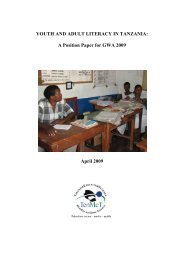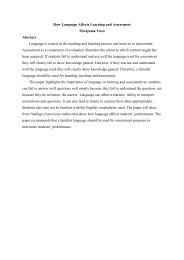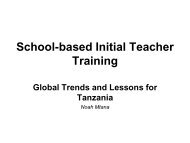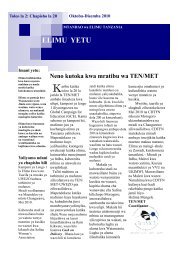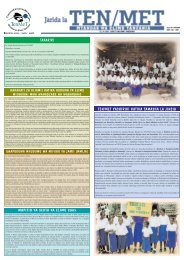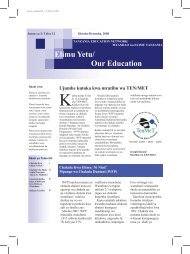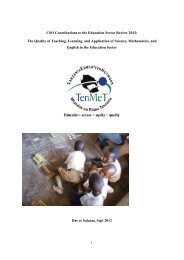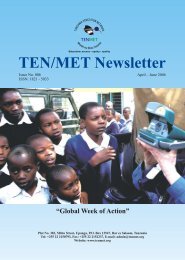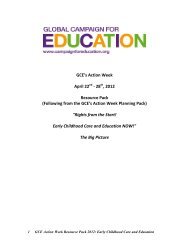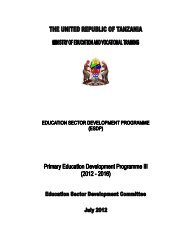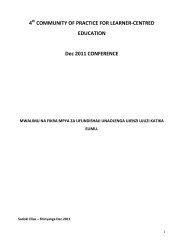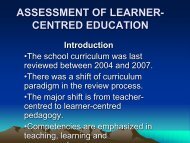A Simple Guide to Working with Finances in Education - Tanzania ...
A Simple Guide to Working with Finances in Education - Tanzania ...
A Simple Guide to Working with Finances in Education - Tanzania ...
Create successful ePaper yourself
Turn your PDF publications into a flip-book with our unique Google optimized e-Paper software.
A <strong>Simple</strong> <strong>Guide</strong> <strong>to</strong> <strong>Work<strong>in</strong>g</strong> <strong>with</strong> <strong>F<strong>in</strong>ances</strong> and <strong>Education</strong>ContentsBudget speech1. Achiev<strong>in</strong>g <strong>Education</strong> for All - where is the money go<strong>in</strong>g <strong>to</strong>come from? …........………….........………....………...........………………… 11.1 Gett<strong>in</strong>g more money ............…………….........……………........….... 11.2 Redistribut<strong>in</strong>g the money that is there ….....……….......….........…... 11.3 Reduc<strong>in</strong>g the cost of provid<strong>in</strong>g primary education …................…… 21.4 Spend<strong>in</strong>g the money there is, accord<strong>in</strong>g <strong>to</strong> plans ….....................….. 22. Introduc<strong>in</strong>g Budget Work……………………......……………..........……..... 32.1 Budget work is often an extension of exist<strong>in</strong>gpolicy and advocacy work ………………........…………….....…...… 32.2 What we can learn from a budget ...…………………............……… 42.3 Basic Budget Pr<strong>in</strong>ciples: How the budget should work .................… 52.4 Why doesn’t this system deliver on pro-poor budgets? …...............… 83. Introduction <strong>to</strong> Budget Systems …….......................................…………… 103.1 Transparency ........………...........……………..........…………………. 11Why does it matter? ……..........…………………..........…………….. 11How does it happen? ……...........………………….........……………. 113.2 Accountability …………...............…………………….........………… 11Why is it important? ......................................……….........…………. 11How do you make accountability happen?….................................… 113.3 Participation ………………………………….........………….. 113.4 Characteristics of a good budget system ......…….......…........……… 123.5 What k<strong>in</strong>ds of questions can you then ask? …..................…..……… 124. Introduction <strong>to</strong> Budget Processes ...……….......................………………… 154.1 Internal Problems ………………………..........…………………….. 154.1.1 Annual bidd<strong>in</strong>g system .....…………………...…………………. 154.1.2 Base budget is not reviewed, but used forau<strong>to</strong>matic “add-ons”………………………....................…………… 154.1.3 Expenditure isn’t related <strong>to</strong> resource availability ….................…… 154.1.4 Strange spend<strong>in</strong>g <strong>in</strong>centives (spend<strong>in</strong>g <strong>in</strong> order <strong>to</strong> spend,or arbitrary cuts) ………………..........…….......……………………. 15
4.1.5 Unrealistic revenue projections ……………......….......…………… 164.1.6 Departmental rather than programme or output orientation .......... 164.1.7 Budget does not capture all spend<strong>in</strong>g ..................………………… 164.2 The impact of external aid ........……...........………………………. 164.2.1 Differences over priorites and how resources are allocated ........... 174.2.2 The way donors operate: “The donor circus” ................………….. 174.3 Examples of Reform …………..……………..........………………… 184.3.1 Public Expenditure Management …............…………….........…….. 184.3.2 Poverty Reduction Strategy …............…………………........……… 184.3.3 Cross-cutt<strong>in</strong>g <strong>in</strong>stitutional and structural reforms…................…….. 194.3.4 Public Expenditure Reviews (PERs) ....………….........….........……. 204.3.5 The Medium Term Expenditure Framework (MTEF)….................…. 204.3.6 Sec<strong>to</strong>r Wide Approach (SWAP)…………….....................…………. 224.3.7 Local Government Reform………………....................…………….. 235. Introduction <strong>to</strong> Understand<strong>in</strong>g Budget Outcomes ................…………….. 255.1 Budget analysis ……………………….........…….............……………. 256. Gett<strong>in</strong>g Started on Budget Work……………......…...........………………… 286.1 Decide on a Research Issue……….......................…………………… 286.2 Assemble the Relevant Documents …….........…..........……………… 286.3 Conduct the Analysis and Dissem<strong>in</strong>ate the F<strong>in</strong>d<strong>in</strong>gs……................… 296.4 Work <strong>with</strong> Partnerships …..…………................……..........………… 306.5 Still Hesitat<strong>in</strong>g? ………......…...................….....................………….. 307. Other Resources and Related Read<strong>in</strong>g ………...…….........………………. 31Useful Websites 31Institutional Framework for Poverty Moni<strong>to</strong>r<strong>in</strong>g <strong>in</strong> <strong>Tanzania</strong> 32Answers <strong>to</strong> Budget Analysis Calculations 33Acknowledgements
1. Achiev<strong>in</strong>g <strong>Education</strong> for All -where is the money go<strong>in</strong>g <strong>to</strong> come from?In many countries there is a problem <strong>with</strong> a ‘f<strong>in</strong>ance gap’ <strong>in</strong> education. This is thedifference between the actual money available and what is needed <strong>to</strong> obta<strong>in</strong> areasonable quality and quantity of education.There is a limited range of th<strong>in</strong>gs which can be done <strong>to</strong> obta<strong>in</strong> the money <strong>to</strong> pay for<strong>Education</strong> for All (EFA). Not all of them are feasible or desirable, but it is necessary <strong>to</strong>know what the options are if we are go<strong>in</strong>g <strong>to</strong> be part of the discussions aboutprioritis<strong>in</strong>g what can be done. The options chosen need <strong>to</strong> be appropriate <strong>to</strong> thesocial, economic, political and cultural context of the country.The options <strong>in</strong>clude:1.1 Gett<strong>in</strong>g more money…This can be done through:• expand<strong>in</strong>g tax <strong>in</strong>come, <strong>in</strong>clud<strong>in</strong>g through new taxes• promot<strong>in</strong>g private schools. These could be ‘for profit’ or ‘not for profit’such as those run by NGOs• <strong>in</strong>creas<strong>in</strong>g household and community contributions• donor aid and debt relief1.2 Redistribut<strong>in</strong>g the money that is there….In many countries, expenditure on primary or basic education accounts for a relativelysmall proportion of <strong>to</strong>tal expenditure. In this situation, redistribution is often advocated:• between sec<strong>to</strong>r (eg. reduc<strong>in</strong>g military expenditure and<strong>in</strong>creas<strong>in</strong>g education spend<strong>in</strong>g)• between sub-sec<strong>to</strong>rs of education (eg. frompost-primary <strong>to</strong> primary, as more childrenaccess primary education than higher levels)‘How do you choose between gunsand books?’‘Higher education is much more, expensivethan primary: which has the greaterimpact on poverty eradication?’• <strong>with</strong><strong>in</strong> the primary level (e.g. from formal <strong>to</strong> nonformaleducation, where non-formal programme arecheaper or more efficient than ord<strong>in</strong>ary schools)• between different types of <strong>in</strong>stitution (e.g. allow<strong>in</strong>gmore private schools <strong>to</strong> open)1
• between types of expenditure (such as between capital spend<strong>in</strong>g (e.g. classroombuild<strong>in</strong>g), salary recurrent (e.g. teachers salaries) and non-salary recurrent (e.g.exercise books and chalk)1.3 Reduc<strong>in</strong>g the cost of provid<strong>in</strong>g primary education…This is also known as ‘reduc<strong>in</strong>g unit costs’ – or lower<strong>in</strong>g the cost of provid<strong>in</strong>geducation <strong>to</strong> a s<strong>in</strong>gle child, so that you can get more children <strong>in</strong><strong>to</strong> school <strong>with</strong>out<strong>in</strong>creas<strong>in</strong>g the overall costs.• chang<strong>in</strong>g pupil: teacher ratios• double/triple shift<strong>in</strong>g of classes• reduc<strong>in</strong>g teachers’ average earn<strong>in</strong>gs• s<strong>to</strong>pp<strong>in</strong>g children from repeat<strong>in</strong>g some years of education if, for example, theydon’t pass the end of year exam.• chang<strong>in</strong>g the length of the school cycle - if for example some non-formaleducation programmes can get a child <strong>to</strong> pass the primary school <strong>in</strong> about 4years, <strong>in</strong> which case why do most children spend 7 years <strong>in</strong> primary school• simplify<strong>in</strong>g the curriculum by hav<strong>in</strong>g fewer subjects and teach<strong>in</strong>g only onelanguage• creat<strong>in</strong>g <strong>in</strong>come earn<strong>in</strong>g schemes at the school level• promot<strong>in</strong>g day schools rather than board<strong>in</strong>g• <strong>in</strong>troduc<strong>in</strong>g cost-shar<strong>in</strong>g, and formaliz<strong>in</strong>g community participation• reduc<strong>in</strong>g capital costs, such as the average cost of classroom construction1.4 Spend<strong>in</strong>g the money there is, accord<strong>in</strong>g <strong>to</strong> plans…Sometimes the amount of money available is not as big a problem as blockages andleakages which s<strong>to</strong>p the money gett<strong>in</strong>g <strong>to</strong> the right place. To understand about theseproblems you need <strong>to</strong> know more about budget systems and processes. These will becovered <strong>in</strong> chapters 3 and 4.2
2. Introduc<strong>in</strong>g Budget Work2.1 Budget work is often an extension of exist<strong>in</strong>g policyand advocacy workNGOs <strong>in</strong>volved <strong>in</strong> advocacy work have for many years been work<strong>in</strong>g <strong>to</strong> po<strong>in</strong>t out <strong>to</strong>decision makers when the impact of a programme or policy is not <strong>in</strong> l<strong>in</strong>e <strong>with</strong> the orig<strong>in</strong>alpolicy statement. The diagram below shows a cha<strong>in</strong> from policy statement, through<strong>in</strong>stitutions and structures of implementation, through <strong>to</strong> service delivery, and ultimately<strong>to</strong> impact. Many NGOs are now see<strong>in</strong>g the importance of budgets as a critical ‘miss<strong>in</strong>gl<strong>in</strong>k’ <strong>in</strong> our understand<strong>in</strong>g of how policy gets translated down <strong>to</strong> the level of impact.3
2.2 What we can learn from a budgetStudy<strong>in</strong>g budgets can help <strong>to</strong> answer the follow<strong>in</strong>g questions:• Adequacy – how much isbudgeted? Is it enough <strong>to</strong> cover thecost of carry<strong>in</strong>g out the policy?• Priority – how does the budget foreducation compare <strong>to</strong> resourcesspent <strong>in</strong> other areas? A governmentcould make promises (policycommitments) <strong>to</strong>wards a particularpolicy, but if this is not reflected <strong>in</strong>the budget it is not keep<strong>in</strong>g itspromises. Look<strong>in</strong>g at what receivesthe most and the least amounts ofmoney <strong>in</strong> an overall budget showyou where the priorities really lie.When you are look<strong>in</strong>g just at the amontrecorded <strong>in</strong> a budget <strong>in</strong> shill<strong>in</strong>gs or dollarsit is called “Nom<strong>in</strong>al terms’. If you arelook<strong>in</strong>g at a budget which comparesseveral years, it is important <strong>to</strong> know ifwhat you are look<strong>in</strong>g at has been adjusted<strong>to</strong> take <strong>in</strong>flation <strong>in</strong><strong>to</strong> account. If it hasn’t,you might th<strong>in</strong>k that the numbers aregrow<strong>in</strong>g up and up, but <strong>in</strong> fact what youcan buy <strong>with</strong> a certa<strong>in</strong> amount of moneyhas gone down. If the numbers you arelook<strong>in</strong>g at have taken <strong>in</strong>flation <strong>in</strong><strong>to</strong>account they are acalled ‘Real terms’.• Progress – is the government’s response <strong>to</strong> meet<strong>in</strong>g educationneeds improv<strong>in</strong>g? It is not always possible <strong>to</strong> make changehappen very fast, but by look<strong>in</strong>g at this years budget <strong>in</strong>comparison <strong>with</strong> last years or the one from five years ago, youcan tell if changes are be<strong>in</strong>g made.• Equity – are resources be<strong>in</strong>g allocated fairly? For example,school<strong>in</strong>g <strong>in</strong> some parts of the country is much <strong>in</strong> advance ofprovision <strong>in</strong> other parts. Is fund<strong>in</strong>g be<strong>in</strong>g used <strong>to</strong> even up thesehis<strong>to</strong>ric differences, or is it be<strong>in</strong>g allocated <strong>in</strong> a way whichma<strong>in</strong>ta<strong>in</strong>s these differences or even makes them worse?• Efficiency – is the money be<strong>in</strong>g spent efficiently. Is there a big difference betweenallocation and actual expenditure? - If so money is not be<strong>in</strong>g spent and put <strong>to</strong> gooduse. There are also different means of gett<strong>in</strong>g money down <strong>to</strong> district and schoollevel, such as block grants or tied grants. Block grants would give freedom <strong>to</strong> districts<strong>to</strong> decide how <strong>to</strong> spend resources <strong>in</strong> order <strong>to</strong> meet local needs. Tied grants directexactly how money must be spent. Capitation and development grants at school levelare tied, as they come <strong>with</strong> strict directions about how money can be allocated.• Effectiveness – is the money be<strong>in</strong>g spent on the right th<strong>in</strong>gs? For example, if theobjective is improved levels of education achievement, where do you allocatespend<strong>in</strong>g <strong>to</strong> have the biggest impact on learn<strong>in</strong>g achievements? Classrooms,teachers, teacher tra<strong>in</strong><strong>in</strong>g…?To be able <strong>to</strong> answer these questions, though, it’s necessary <strong>to</strong> understand howbudgets should work.4
2.3 Basic Budget Pr<strong>in</strong>ciples: How the budget should work.As a <strong>to</strong>ol of economic policy, the budget is the means by which the governmentseeks <strong>to</strong> achieve three key economic policy goals:a) ‘Fiscal discipl<strong>in</strong>e’, which means controll<strong>in</strong>g overall government spend<strong>in</strong>g so itdoesn’t go beyond what money has been raised.b) Allocation of resources <strong>in</strong> l<strong>in</strong>e <strong>with</strong> the government’s policy goals. Good budgetsshould start <strong>with</strong> an assessment of what needs have <strong>to</strong> be met, followed by plansof how <strong>to</strong> meet those needs, followed by a budget.c) The economic, efficient and effective use of resources <strong>in</strong> achiev<strong>in</strong>g its policy goalsIn addition, the budget tells public <strong>in</strong>stitutions, such as m<strong>in</strong>istries or schools, what thepolicy priorities are by <strong>in</strong>form<strong>in</strong>g them how much may be spent for what purpose,thereby guid<strong>in</strong>g policy implementation.F<strong>in</strong>ally, the budget process should mean that the government is accountable <strong>to</strong> theelected representatives of the people. Government may not raise taxes that havenot been approved by parliament and may not raise more money than parliament hassaid they can. If they do, it is called ‘exceed<strong>in</strong>g expenditure appropriations.’Budget work <strong>in</strong> cycles, and the diagram on the follow<strong>in</strong>g page shows what is <strong>in</strong> thecycle. It should take about three years <strong>to</strong> complete a cycle, <strong>in</strong> the first year the budgetis be<strong>in</strong>g prepared and approved, <strong>in</strong> the second it is be<strong>in</strong>g implemented and <strong>in</strong> thethirds year accounts for it are submitted and approved.5
The timetable for this as it works <strong>in</strong> <strong>Tanzania</strong>, is:Month National level – f<strong>in</strong>ancial year District level – f<strong>in</strong>ancial year runsruns from July <strong>to</strong> Junefrom January <strong>to</strong> DecemberMay Preparation of national budgetJune Presentation of budget <strong>to</strong> parliamentJuly Discussion of budget <strong>in</strong> parliamentAugustSeptemberPlans developed at district level aboutOc<strong>to</strong>ber Work on budget guidel<strong>in</strong>es, by the spend<strong>in</strong>g for com<strong>in</strong>g f<strong>in</strong>ancial year,guidel<strong>in</strong>es committee.<strong>in</strong>clud<strong>in</strong>g use of locally raised taxes.NovemberDiscussed first <strong>with</strong> District ManagementTeam, then F<strong>in</strong>ance CommitteeDecemberFull council meet<strong>in</strong>g at which plans/budgets for follow<strong>in</strong>g f<strong>in</strong>ancial year atdistrict level are approvedJanuary Issu<strong>in</strong>g of budget guidel<strong>in</strong>e through Budget guidel<strong>in</strong>es arrive for PO-RALGPO-RALG <strong>to</strong> local government resources for f<strong>in</strong>ance year start<strong>in</strong>g theAuthoritiesfollow<strong>in</strong>g JulyFebruary preparation of budget submissions Local government authorities learnby <strong>in</strong>dividual sec<strong>to</strong>rs (and also of what money will be available directMTEFs – about which there is from MOEC; sometimes arrives latemore <strong>in</strong> chapter 4)MarchDistricts produce budgets which arebrought <strong>to</strong>gether through RegionalConsolidation Committee. Last quarterof previous year’s f<strong>in</strong>ance also reportedat this time.AprilRegional Adm<strong>in</strong>istrative Secretary takesthis <strong>to</strong> PO-RALGMay Preparation of National budgetJune Presentation of budget <strong>to</strong> parliamentJuly Discussion of budget <strong>in</strong> parliamentAugustSeptember7
Budgets, gender and meet<strong>in</strong>g the needs of the marg<strong>in</strong>alisedThe budget on the face of it appears <strong>to</strong> be gender neutral - <strong>in</strong> other words it doesn’taffect women more than men (or the other way around). Usually there is noparticular mention of women or men. However the way <strong>in</strong> which national budgetsare usually formulated ignores the different roles, responsibilities and capabilities ofmen and women. Gender budget moni<strong>to</strong>r<strong>in</strong>g looks at this fac<strong>to</strong>rs <strong>to</strong> see if thebudget is gender-sensitive. In <strong>Tanzania</strong> TGNP (<strong>Tanzania</strong> Gender NetworkProgramme) have a gender budget <strong>in</strong>itiative <strong>in</strong> which they consider howgovernment money is be<strong>in</strong>g allocated and spent and who is benefitt<strong>in</strong>g from it.They use the <strong>in</strong>formation they f<strong>in</strong>d <strong>in</strong> their lobby<strong>in</strong>g and advocacy activities. Thereis also the possibility <strong>to</strong> do a budget analysis <strong>to</strong> show if spend<strong>in</strong>g is meet<strong>in</strong>g the<strong>in</strong>terests of other groups <strong>in</strong> society such us children or the disabled.2.4 Why doesn’t this system deliver on pro-poor budgets?There is gap between stated policy and practice, which <strong>in</strong> general comes out of tensionsbetween government and door priorities, national and local priorities and betweendifferent political parties. In particular the follow<strong>in</strong>g specific problems can be seen.1) Lack of good <strong>in</strong>formation and accurate diagnosis of the problems andpriorities of the poor, and how government action may help <strong>to</strong> move them ou<strong>to</strong>f poverty. The National Poverty Moni<strong>to</strong>r<strong>in</strong>g Strategy should help <strong>with</strong> this, <strong>in</strong>particular the <strong>Tanzania</strong> Participa<strong>to</strong>ry Poverty Assessment 1 . Sec<strong>to</strong>r studies cancontribute <strong>to</strong> understand<strong>in</strong>g connections between education and povertyeradication.2) Failure <strong>to</strong> direct government expenditure <strong>to</strong>wards the priorities that areconsistent <strong>with</strong> the diagnosis of problems and solutions. This is an issue ofbudget systems and how they work, and will be return <strong>to</strong> shortly. Sometimes itsis due <strong>to</strong> donor pressure not co<strong>in</strong>cid<strong>in</strong>g <strong>with</strong> government priorities. Sometimesits is due <strong>to</strong> <strong>in</strong>ternal problems like always build<strong>in</strong>g on the previous year’s budgetrather than work<strong>in</strong>g on the basis of needs.3) Lack of good feedback mechanisms of moni<strong>to</strong>r<strong>in</strong>g the effect of governmentpolicies and programmes and for corrective action where necessary. Aga<strong>in</strong> theNational Poverty Moni<strong>to</strong>r<strong>in</strong>g Strategy should be of assistance <strong>with</strong> this.1For further <strong>in</strong>formation see http://www.esrftz.org/ppa8
4) Lack of accountability; weak or <strong>in</strong>effective pressure on government <strong>to</strong> deliveron stated policies and/or <strong>to</strong> change policies. This is <strong>to</strong> do <strong>with</strong> the strength ofdemocratic structures and the capacity of key players like councillors at districtlevel and of civil society.5) Difficulties <strong>in</strong> build<strong>in</strong>g the budget from the bot<strong>to</strong>m up and <strong>to</strong> ensure thatgrassroots priorities and resources are taken <strong>in</strong><strong>to</strong> account. Most budget atdistrict level use district and national level resources, they are not built fromvillage and ward level upwards. Some parts of the county have been try<strong>in</strong>g <strong>to</strong>implement a system which would enable local level plann<strong>in</strong>g <strong>to</strong> be taken <strong>in</strong><strong>to</strong>account at district level. More details of this are given on page 24.9
3. Introduction <strong>to</strong> Budget SystemsThe overall budget is made up of the system, the policy and the outcomes. They canbe thought of like this:Budget SystemBudget PolicyBudget OutcomesThe system bywhich resources arecollected, allocated,recorded, moni<strong>to</strong>redand accounted for.A good budget system willproduce good budgetpolicy. This is the overalleffect of the annualallocation of resources.This will ensure that <strong>to</strong>talspend<strong>in</strong>g is affordable, thatresources are spent onpriorities and are spentwell not wasted on<strong>in</strong>efficiency and corruption• How much money isspent?• On what is it spent?• How well is it spent?The budget system is like the rules of the game. Transparency and accountability canbe the way <strong>to</strong> check that the rules are be<strong>in</strong>g followed. They only work if peopleparticipate <strong>in</strong> budget processes, but people cannot participate unless they know thesystem and the rules and what is meant <strong>to</strong> be happen<strong>in</strong>g. If this is achieved you havean ‘open budget’. It is like a cook<strong>in</strong>g pot rest<strong>in</strong>g on three strong s<strong>to</strong>nes, and the threes<strong>to</strong>nes are participation, transparency and accountability.10
3.1 TransparencyWhy does it matter?• In a democracy, citizens have the right <strong>to</strong> <strong>in</strong>formation on the affairs of their electedgovernment.• Transparency helps <strong>to</strong> create better decision mak<strong>in</strong>g <strong>in</strong> government as everyth<strong>in</strong>gis done <strong>in</strong> the open.• Without transparency and access <strong>to</strong> <strong>in</strong>formation, there can’t be effectiveparticipation by parliament and civil society.How does it happen?You need the right <strong>in</strong>stitutional arrangements – such as publish<strong>in</strong>g of <strong>in</strong>formation which:• covers everyth<strong>in</strong>g people need <strong>to</strong> know – <strong>in</strong> other words it is comprehensive,• is provided early enough for organizations <strong>to</strong> study it and work out its implications– <strong>in</strong> other words it is timely,• is accurate and,• is <strong>in</strong> an easily unders<strong>to</strong>od format – <strong>in</strong> other words it is useful.3.2 AccountabilityWhy is it important?It helps promote better decision-mak<strong>in</strong>g which responds <strong>to</strong> the needs of the elec<strong>to</strong>rateHow do you make accountability happen?• Strong f<strong>in</strong>ancial management systems – for example, <strong>in</strong> some countries it takes years<strong>to</strong> get <strong>in</strong>formation on what money was actually spent and on what, which means ifanyth<strong>in</strong>g has been spent not <strong>in</strong> l<strong>in</strong>e <strong>with</strong> allocations, it is often <strong>to</strong>o late <strong>to</strong> follow it up.• Strong f<strong>in</strong>ancial management legislation – so that anyone who doesn’t followcorrect systems and procedures can be prosecuted.• An <strong>in</strong>dependent Audi<strong>to</strong>r General. Only if they are properly <strong>in</strong>dependent can theyfollow up any evidence that money was improperly allocated or spent.• Strong well-<strong>in</strong>formed parliament, civil society and media.• Aware elec<strong>to</strong>rate.3.3 ParticipationBetter participation promotes better budget outcomes, because it:• promotes public debate;• promote accountability;• promotes the build<strong>in</strong>g of consensus around policy choices. (Always there are trade-offs<strong>to</strong> be made, such as <strong>in</strong> select<strong>in</strong>g the priority sec<strong>to</strong>rs for the Poverty Reduction Strategy);• promotes stability as opposed <strong>to</strong> sw<strong>in</strong>gs <strong>in</strong> policy, which might be damag<strong>in</strong>g ordestabilis<strong>in</strong>g.11
• Are these committees <strong>in</strong>tegrated <strong>in</strong> the entireproject management and life cycle? Or are theyonly there for ‘agree<strong>in</strong>g <strong>to</strong> the project’, or notgiven <strong>in</strong>formation on parts of the project?• How are resources disbursed <strong>to</strong> district level?Who controls local government spend<strong>in</strong>g?13
4. Introduction <strong>to</strong> Budget ProcessesSection 2.3 expla<strong>in</strong>ed what the budget cycle is like. It is an ideal pattern, but theproblem is that it doesn’t create budgets which are <strong>in</strong> favour of the poor. Section 2.4expla<strong>in</strong>ed some of the reasons for this. All of the reasons have a strong politicaldimension, but they can be made worse by technical problems <strong>with</strong> budget systemsand processes. Some of these are ‘<strong>in</strong>ternal’ and some of them are ‘external’, mean<strong>in</strong>gthey are related <strong>to</strong> the activities of donors. They are expla<strong>in</strong>ed below.4.1 Internal Problems4.1.1 Annual bidd<strong>in</strong>g systemGovernment budgets are prepared us<strong>in</strong>g a bidd<strong>in</strong>g system, <strong>in</strong> which each m<strong>in</strong>istry anddepartment ‘bids’ for how much money they would like <strong>to</strong> have, and then this getscut back <strong>to</strong> fit <strong>with</strong> the amount of resources available or <strong>in</strong> l<strong>in</strong>e <strong>with</strong> priorities. Thisway of mak<strong>in</strong>g budgets can make it difficult <strong>to</strong> relate <strong>in</strong>puts <strong>to</strong> activities orperformance as measured by the services provided (outputs) or their impact on thepublic (outcomes). This leads <strong>to</strong> <strong>in</strong>efficient and wasteful use of available resources.4.1.2 Base budget is not reviewed, but used for au<strong>to</strong>matic“add-ons”M<strong>in</strong>istries and Departments’ bids generally take the previous year’s budget as the baseand request additional fund<strong>in</strong>g. Ideally this would be on the basis of an expansion ofthe services <strong>to</strong> be provided, but more often it is just a percentage <strong>in</strong>crease. With thisapproach there is little scope <strong>to</strong> review the relevance, efficiency and effectiveness ofexist<strong>in</strong>g programmes or the level of adm<strong>in</strong>istrative overheads.4.1.3 Expenditure isn’t related <strong>to</strong> resource availabilityS<strong>in</strong>ce base expenditures are taken as fixed, they can become the start<strong>in</strong>g po<strong>in</strong>t for thewhole budget process rather than determ<strong>in</strong><strong>in</strong>g expenditures on the basis of resourceavailability.4.1.4 Strange spend<strong>in</strong>g <strong>in</strong>centives (spend<strong>in</strong>g <strong>in</strong> order <strong>to</strong> spend,or arbitrary cuts)M<strong>in</strong>istries and Departments’ will tend <strong>to</strong> bid high because they expect their proposals<strong>to</strong> be cut back. As a result,• The M<strong>in</strong>istry of F<strong>in</strong>ance will be faced <strong>with</strong> overall spend<strong>in</strong>g proposals that greatlyexceed the overall resources, and they impose cuts. They have <strong>to</strong> work <strong>to</strong> a tight timedeadl<strong>in</strong>e and don’t always understand the needs and priorities of the spend<strong>in</strong>gm<strong>in</strong>istry or department, so what they cut may not be what the M<strong>in</strong>istry would choose.15
• S<strong>in</strong>ce the m<strong>in</strong>istry or department, does not feel directly responsible for the f<strong>in</strong>albudget figures it has little commitment <strong>to</strong> the limits imposed.• Spend<strong>in</strong>g m<strong>in</strong>istries and departments will tend <strong>to</strong> commit funds asquickly as possible, for fear that later cuts will be imposed. They may even commitbeyond their official spend<strong>in</strong>g limits. The recently <strong>in</strong>troduced computerized systemof government Local Purchase Orders <strong>in</strong> <strong>Tanzania</strong> is meant <strong>to</strong> put an end <strong>to</strong> this,as it is not possible <strong>to</strong> order someth<strong>in</strong>g if there isn’t the money <strong>to</strong> pay for it.• M<strong>in</strong>istries and departments have no <strong>in</strong>centive <strong>to</strong> make sav<strong>in</strong>gs. Each agencyneeds <strong>to</strong> fully spend its budget by any means necessary. To avoid underspend<strong>in</strong>g,there is often a surge <strong>in</strong> agency spend<strong>in</strong>g <strong>in</strong> the last quarter, often onitems which are not very high priority.4.1.5 Unrealistic revenue projectionsThese may make the problem worse, because the amount that f<strong>in</strong>ally is available <strong>to</strong>spend<strong>in</strong>g m<strong>in</strong>istries or departments is not <strong>in</strong> l<strong>in</strong>e <strong>with</strong> what they expected and planned for.4.1.6 Departmental rather than programme or output orientationBudgets are prepared by, and for, adm<strong>in</strong>istrative units rather than on the basis of thegovernment’s objectives, programmes and activities. The first priority is keep<strong>in</strong>g theadm<strong>in</strong>istrative mach<strong>in</strong>ery runn<strong>in</strong>g smoothly, and often not enough is left for activities.This results <strong>in</strong> schools <strong>with</strong>out books, or <strong>in</strong>spection services <strong>with</strong>out fuel for theirvehicles so they cannot visit schools.4.1.7 Budget does not capture all spend<strong>in</strong>gIt was said above (3.4) that a good budget is ‘comprehensive’ mean<strong>in</strong>g that everyth<strong>in</strong>gon which government spends money is <strong>in</strong>cluded. If the budget does not give a fullpicture it is very difficult <strong>to</strong> see whether spend<strong>in</strong>g allocations are be<strong>in</strong>g made <strong>in</strong> l<strong>in</strong>e <strong>with</strong>stated policy priorities. Commitments <strong>to</strong> parastatals are often not covered <strong>in</strong> the budget.Until recently most donor support came <strong>in</strong> the form of projects, which meant thatgovernment didn’t actually know how much was be<strong>in</strong>g spent. There is more about thisbelow.4.2 The impact of external aidImplementation of governmentpriorities may be held back by theway donors or developmentpartners work.How many of theseproblems are also true ofNGOs?What can be doneabout it?16
4.2.1 Differences over priorities and how resources are allocatedIf government and donor priorities do not co<strong>in</strong>cide, donors can be fund<strong>in</strong>g an aspec<strong>to</strong>f education which government is not prioritis<strong>in</strong>g. In this way, the impact of donor aidcan dis<strong>to</strong>rt overall spend<strong>in</strong>g <strong>in</strong> the sec<strong>to</strong>r.• Few bilateral donor or development partners 2 fund recurrent costs, aid oftenproduces a bias <strong>to</strong>wards <strong>in</strong>frastructure projects <strong>with</strong> <strong>in</strong>adequate support forongo<strong>in</strong>g runn<strong>in</strong>g costs (e.g.. lots of classrooms, but not enough teachers or books)• Sometimes donors have a preference for fund<strong>in</strong>g certa<strong>in</strong> parts of the country andthis can result <strong>in</strong> uneven (or duplicate) provision of services, projects that areexpensive <strong>to</strong> manage, and a lack of susta<strong>in</strong>ability. In the worst cases, governmentsmay not know how much donors spend, on what, or the time frame for support.4.2.2 The way donors operate: “The donor circus”These are examples of problems which have been experienced, or are still be<strong>in</strong>gexperienced.• The erratic and unpredictable nature of donor disbursements cancause budget <strong>in</strong>stability and can lead <strong>to</strong> the bunch<strong>in</strong>g ofexpenditure at the wrong times. In addition donors are oftenunwill<strong>in</strong>g <strong>to</strong> make commitments beyond the short term.For example <strong>in</strong> the global Fast Track Initiative donors failed<strong>to</strong> give details of the aid flows they will deliver over 3 years<strong>to</strong> the first 7 qualify<strong>in</strong>g Fast Track countries.• If one donor sees itself as hav<strong>in</strong>g special expertise <strong>in</strong> aparticular area, they sometimes implement and fundaccord<strong>in</strong>g <strong>to</strong> their own procedures. And then another seesitself as hav<strong>in</strong>g special expertise <strong>in</strong> another area and does thesame…and so on. The overall impact may not add up <strong>to</strong> coherent improvements <strong>in</strong>the sec<strong>to</strong>r. This was the situation <strong>in</strong> the M<strong>in</strong>istry of <strong>Education</strong> <strong>in</strong> <strong>Tanzania</strong> for much ofthe 1990s when there were so many projects be<strong>in</strong>g run <strong>in</strong> the M<strong>in</strong>istry there wasalmost a ‘parallel structure’ of donor support.• Sometimes, m<strong>in</strong>istries may undertake their own negotiations <strong>with</strong> donors <strong>with</strong>out theknowledge of the M<strong>in</strong>istry of F<strong>in</strong>ance, and receive project fund<strong>in</strong>g that is not captured<strong>in</strong> the budget.• Perhaps most serious of all, some donor projects have tended <strong>to</strong> be set up outside coregovernment systems, often employ<strong>in</strong>g their own staff This can result <strong>in</strong> dra<strong>in</strong><strong>in</strong>gcapacity from government when the need is <strong>to</strong> build it. Senior government personnelspend time deal<strong>in</strong>g <strong>with</strong> account<strong>in</strong>g and report<strong>in</strong>g requirements which are differentfor each donor, rather than manag<strong>in</strong>g the development of the whole sec<strong>to</strong>r.2 Bilateral just means the relations between two countries, the donor (such as Sweden, Brita<strong>in</strong>, Japan etc) andgovernment of <strong>Tanzania</strong>. UN agencies such as Unicef, UNDP, etc are usually referred <strong>to</strong> as’ developmentpartners’.17
4.3 Examples of ReformGovernment and donors are aware ofthese problems, and a numberof different processes are meant <strong>to</strong>solve the problem.Unfortunately, not everyoneis aware of the process and theirimplications. Sometimes they have been<strong>in</strong>troduced <strong>with</strong>out enough support for capacitydevelopment. Most of the processes create newopportunities for civil society <strong>to</strong> be <strong>in</strong>volved butwe need also <strong>to</strong> understand how they work.Everyth<strong>in</strong>g is not as neat, tidy and well unders<strong>to</strong>odby all players as it might seem!4.3.1 Public Expenditure ManagementThe overall approach is called Public Expenditure Management (PEM). The overall ideais that government and donors should work <strong>to</strong>gether <strong>to</strong> implement a s<strong>in</strong>gle expenditureprogramme which prioritises the use of all sources of fund<strong>in</strong>g for public expenditure,across all sec<strong>to</strong>rs. This aims <strong>to</strong> be medium term (3-5 years), cover all sources of fund<strong>in</strong>gand l<strong>in</strong>k the money allocated <strong>in</strong> the budget <strong>to</strong> the objectives which have been agreedupon. Donors on their side are meant <strong>to</strong> offer flexible budgetary support <strong>to</strong> an agreedprogramme of policy reforms, rather than <strong>to</strong> <strong>in</strong>dividual ‘pet projects’.This is how it is supposed <strong>to</strong> work.4.3.2 Poverty Reduction StrategyGovernment develops an overall strategy or vision for susta<strong>in</strong>able development, suchas the Poverty Reduction Strategy. This establishes sec<strong>to</strong>ral priorities for governmentand donor spend<strong>in</strong>g. may also redef<strong>in</strong>e the roles which governmentwill play <strong>with</strong><strong>in</strong> each sec<strong>to</strong>r (e.g. privatisation of parastatals). should be based on good diagnostic <strong>in</strong>formation (e.g. Poverty Assessments),and is supposed <strong>to</strong> develop from a participa<strong>to</strong>ry process, <strong>with</strong><strong>in</strong> whichpoor and vulnerable groups have been represented.The idea is <strong>to</strong> reach consensus on a set of achievable longer-term priorities, whichhave enough support <strong>to</strong> enable government <strong>to</strong> shift resources <strong>in</strong><strong>to</strong> areas that will havean impact on those priorities, such as basic social services, or basic <strong>in</strong>frastructure.In theory, PRSPs are just one way of develop<strong>in</strong>g such a strategy. In practice they havebecome a condition for access <strong>to</strong> debt relief under HIPC2, and for further IMF andWorld Bank budgetary support such as the Fund’s PRGF (Poverty Reduction and GrowthFacility). A PRSP has <strong>to</strong> be approved <strong>in</strong> Wash<strong>in</strong>g<strong>to</strong>n by the IMF and the World Bank.18How goodwas thatparticipation?
Because an agreement <strong>with</strong> the Fund also acts as a “stamp of approval” for bilateraldonors, PRSPs are <strong>in</strong>creas<strong>in</strong>gly important <strong>in</strong> negotiat<strong>in</strong>g access <strong>to</strong> bilateral aid grants. Thespecific features of PRSPs <strong>in</strong>clude a strong l<strong>in</strong>k <strong>to</strong> the 2015 Millenium Development Goals(<strong>in</strong>clud<strong>in</strong>g UPE by 2015); emphasis on reduc<strong>in</strong>g or cutt<strong>in</strong>g what the Bank and Fund seeas unproductive state <strong>in</strong>tervention through liberalization, deregulation anddecentralization. The idea is <strong>to</strong> focus the rema<strong>in</strong><strong>in</strong>g areas of government <strong>in</strong>volvement onactivities where state <strong>in</strong>tervention is cleary neccesary <strong>to</strong> improve poor people’slivelihoods, rather than areas which some would say the private sec<strong>to</strong>r can do better.In <strong>Tanzania</strong> education was identified as a priority sec<strong>to</strong>r for spend<strong>in</strong>g, because of itswell-documented l<strong>in</strong>kages <strong>with</strong> poverty alleviation.For education the targets are:• reduce illiteracy by 100% by 2010• raise gross primary school enrolment <strong>to</strong> 85% by 2003• <strong>in</strong>crease the proportion of school age children complet<strong>in</strong>g primary education by 2003• expand adult education programmes• <strong>in</strong>crease the number of students pass<strong>in</strong>g the standard 7 exam<strong>in</strong>ation at a reasonablyhigh standard (<strong>to</strong> be specified) from 20% <strong>to</strong> 50% by 2003• achieve gender equality <strong>in</strong> primary <strong>to</strong> secondary education by 2005• <strong>in</strong>crease the transition rate from primary <strong>to</strong> secondary from 15% <strong>to</strong> 21%• reduce the drop out rate from primary from 6.6% <strong>to</strong> 3% by 2003Moni<strong>to</strong>r<strong>in</strong>g of the PRS <strong>in</strong> <strong>Tanzania</strong> specifies the role of civil society <strong>in</strong> moni<strong>to</strong>r<strong>in</strong>g theimpact of spend<strong>in</strong>g <strong>in</strong> the priority sec<strong>to</strong>rs 3 . Meet<strong>in</strong>gs such as the Poverty Policy Weekand the Consultative Group Informal Meet<strong>in</strong>g, as well as processes such as the PublicExpenditure Review ga<strong>in</strong> very positively from grassroots experience be<strong>in</strong>g aired beforewider groups of stakeholders, and there are NGOs represented on all of the work<strong>in</strong>ggroups of the National Poverty Moni<strong>to</strong>r<strong>in</strong>g System. A diagram of this system is<strong>in</strong>cluded at the back of this booklet, and TEN/MET can be contacted for a current lis<strong>to</strong>f the represented on the various committee and technical work<strong>in</strong>g groups.4.3.3 Cross-cutt<strong>in</strong>g <strong>in</strong>stitutional and structural reformsThese put <strong>in</strong> place the “necessary” framework <strong>to</strong> support sec<strong>to</strong>r development. This<strong>in</strong>cludes reforms <strong>in</strong> macro-economic and budget management (e.g. the <strong>in</strong>troductionof performance targets), civil service reform, and changes <strong>in</strong> legal and regula<strong>to</strong>rystructures. These reforms often appear as conditions attached <strong>to</strong> IMF and World Banklend<strong>in</strong>g. They are then also attached <strong>to</strong> IMF benchmarks/performance criteria related<strong>to</strong> foreign exchange regimes, fiscal management, tax and cus<strong>to</strong>ms reform, tradeliberalisation etc.3 See for example, HakiKazi Catalyst (2001) <strong>Tanzania</strong> Without Poverty; and Institutional Framework for PovertyMoni<strong>to</strong>r<strong>in</strong>g - <strong>in</strong>cluded at the back of this booklet.19
4.3.4 Public Expenditure Reviews (PERs)Thes are carrried out as a way of provid<strong>in</strong>g the analytical basis for budget reform. PERsare based on the same basic assumptions as PRSPs. PERs look at the previous year’sspend<strong>in</strong>g, <strong>to</strong> evaluate whether poor people benefit from exist<strong>in</strong>g spend<strong>in</strong>g patterns andwhat outcomes are be<strong>in</strong>g achieved. They make recommendations on cutt<strong>in</strong>g or shift<strong>in</strong>gspend<strong>in</strong>g <strong>with</strong><strong>in</strong> sec<strong>to</strong>rs. There is also concern <strong>to</strong> ensure that spend<strong>in</strong>g is cost effective,is equitable, and doesn’t spend government money where the private sec<strong>to</strong>r couldoperate. PER recommendations may re-appear as conditions/benchmarks <strong>in</strong> Bank andFund loans. Each sec<strong>to</strong>r has a PER which contributes <strong>to</strong> the overall national PER.The purpose of the education PER is <strong>to</strong> evaluate the previous year’s spend<strong>in</strong>g <strong>in</strong> theeducation sec<strong>to</strong>r - whether it was <strong>in</strong> l<strong>in</strong>e <strong>with</strong> plans, and whether by keep<strong>in</strong>g <strong>to</strong> the plans,the desired outcomes are likely <strong>to</strong> be achieved. This means look<strong>in</strong>g at the <strong>in</strong>puts (such asfor education, pr<strong>in</strong>cipally money from government and donor resources), the processes(whether the money was properly spent and accounted for), the outputs (teachersemployed, classrooms built), and, ultimately, outcomes (such as a more conducivelearn<strong>in</strong>g environment for pupils). With a focus on poverty, the <strong>in</strong>terest is not just on thelearn<strong>in</strong>g environment as an end <strong>in</strong> itself, but beyond that <strong>to</strong> whether the education systemas a whole is play<strong>in</strong>g its part <strong>in</strong> break<strong>in</strong>g the cycle of poverty and vulnerability.The PER process specifically looks for CSO <strong>in</strong>put <strong>in</strong> assess<strong>in</strong>g the effectiveness ofspend<strong>in</strong>g, and there is CSO <strong>in</strong>volvement <strong>in</strong> the relevant work<strong>in</strong>g groups <strong>to</strong> this end.An up-<strong>to</strong>-date list of the NGOs <strong>in</strong>volved <strong>in</strong> <strong>Tanzania</strong> can be obta<strong>in</strong>ed from TEN/MET.4.3.5 The Medium Term Expenditure Framework (MTEF)This process allocates government and donor resources between compet<strong>in</strong>g priorities.MTEF establishes a 3 years roll<strong>in</strong>g budget focused on activities and outputs <strong>in</strong> l<strong>in</strong>e <strong>with</strong>priorities emerg<strong>in</strong>g from the Poverty Reduction Strategy (and PER), Roll<strong>in</strong>g means thateach year it is adjusted <strong>to</strong> take account of what happened <strong>in</strong> the first year of theprevious MTEF, creat<strong>in</strong>g a new three year plan.The MTEF tries <strong>to</strong> br<strong>in</strong>g <strong>to</strong>gether the amount of resources, which are likely <strong>to</strong> beavailable (<strong>with</strong>out caus<strong>in</strong>g macro-economics problems, like high <strong>in</strong>flation) <strong>with</strong> abot<strong>to</strong>m up estimate of the current and medium term costs of carry<strong>in</strong>g out nationalpriorities as def<strong>in</strong>ed <strong>in</strong> the PRS. Each year there is a back and forth process of agree<strong>in</strong>gthe budget by look<strong>in</strong>g at the resource constra<strong>in</strong>ts and the spend<strong>in</strong>g needs, through theissu<strong>in</strong>g of budget guidel<strong>in</strong>es (see the <strong>in</strong>formation on the budget cycle).The MTEF and PER are meant <strong>to</strong> help the M<strong>in</strong>istry of F<strong>in</strong>ance get away from mak<strong>in</strong>garbitrary cuts on, for example, the education budget, by mak<strong>in</strong>g the educationplanners look very carefully at how they are spend<strong>in</strong>g the resources, and close downany areas of work which are not <strong>in</strong> l<strong>in</strong>e <strong>with</strong> priorities.20
The MTEF and PER can both be part of a process of promot<strong>in</strong>g accountability, if civilsociety organisations and parliament have access <strong>to</strong> <strong>in</strong>formation and are part of theprocess of evaluat<strong>in</strong>g the pro-poor impact of spend<strong>in</strong>g. The follow<strong>in</strong>g calendar showswhen the different processes are tak<strong>in</strong>g place. At national level the f<strong>in</strong>ancial year runsfrom the July <strong>to</strong> June, so that the budget session of parliament is discuss<strong>in</strong>g details ofsec<strong>to</strong>r budgets from July onwards, after the ma<strong>in</strong> budget has been presented <strong>to</strong>parliament by the M<strong>in</strong>ister of F<strong>in</strong>ance <strong>in</strong> June of each year.Month PER Activities Budget ProcessJulyAugustPER <strong>Work<strong>in</strong>g</strong> Group (all sec<strong>to</strong>rs)develops work plan for year<strong>Education</strong> Sec<strong>to</strong>r PER groupdevelops terms of reference forthe reviewDiscussion of budget <strong>in</strong> parliament<strong>Education</strong> PER takes place <strong>in</strong> Work on national budgetSeptember time <strong>to</strong> feed f<strong>in</strong>d<strong>in</strong>gs <strong>in</strong><strong>to</strong> budget guidel<strong>in</strong>es for the follow<strong>in</strong>g year,guidel<strong>in</strong>esby the <strong>Guide</strong>l<strong>in</strong>es CommitteePoverty Policy Week is usuallyOc<strong>to</strong>ber Oc<strong>to</strong>berNovember Some PER work still be<strong>in</strong>g f<strong>in</strong>alized F<strong>in</strong>alisation of guidel<strong>in</strong>esDecemberJanuary PER studies reviewed Issu<strong>in</strong>g of guidel<strong>in</strong>es <strong>to</strong> Municipaland District AuthoritiesFebruaryPreparation of budget for eachsec<strong>to</strong>r (eg education, health etc)Marchand preparation of MTEFApril This is meant <strong>to</strong> be a ‘quiet time’ F<strong>in</strong>alisation of budgetMay so government can get on <strong>with</strong>June budget preparations. Presentation of budget <strong>to</strong> parliamentThe PER and the budget process should not be parallel processes, the PER is designed<strong>to</strong> try and make the budget reflect policy priorities more strongly.21
4.3.6 Sec<strong>to</strong>r Wide Approach (SWAP)In <strong>Tanzania</strong> this is the Sec<strong>to</strong>r Development Programme (EdSDP) and the Primary<strong>Education</strong> Development Programme (PEDP) is a component of it. Sec<strong>to</strong>r reform <strong>in</strong>education <strong>in</strong> <strong>Tanzania</strong> has been under discussion s<strong>in</strong>ce 1995, but the first real fruitswere seen <strong>with</strong> the development of PEDP <strong>in</strong> 2001/2.Sec<strong>to</strong>r reform is also a component of public expenditure management, as the idea isthat the whole sec<strong>to</strong>r is governed by one budget <strong>with</strong> clear priorities, rather than anumber of different donor funded projects. Past experience has shown these do notnecessarily add up <strong>to</strong> improved sec<strong>to</strong>r performance.The idea is that PEDP and EdSDP should be consistent <strong>with</strong> the PRS, the PER and theMTEF, and should ensure that any relevant IMF and World Bank conditionalities aremet. Both government and donor resources are then allocated <strong>in</strong> l<strong>in</strong>e <strong>with</strong> theprogramme.Sec<strong>to</strong>r Wide Approaches also usually aim <strong>to</strong> improve the efficiency and povertytarget<strong>in</strong>g of spend<strong>in</strong>g <strong>in</strong> the sec<strong>to</strong>r, and <strong>to</strong> establish shared donor-government policypriorities (<strong>in</strong>clud<strong>in</strong>g the Millennium Development Goals/EFA goals). These are thenmeant <strong>to</strong> be f<strong>in</strong>anced through a common pool of donor fund<strong>in</strong>g. There is a group ofdonors who are contribut<strong>in</strong>g <strong>to</strong> the education sec<strong>to</strong>r <strong>in</strong> this way – the ‘pooled funddonors’ <strong>in</strong>clud<strong>in</strong>g Sweden, the Netherlands, Ireland and others.22
4.3.7 Local Government ReformThe Local Government Reform Programme is part of the process of mak<strong>in</strong>ggovernment more efficient by address<strong>in</strong>g possible problems of <strong>in</strong>flexibility <strong>in</strong> nationalbudgets. If spend<strong>in</strong>g decisions are made closer <strong>to</strong> the level where the impact is feltthen they are more likely <strong>to</strong> reflect local needs. The idea of mak<strong>in</strong>g decisions closer<strong>to</strong> where the impact will be felt is also beh<strong>in</strong>d giv<strong>in</strong>g <strong>in</strong>dividual schools some power<strong>to</strong> allocate spend<strong>in</strong>g from capitation and development grants.When local government bodies such as the District Council Social Services Committeemake decisions about fund<strong>in</strong>g allocations, it creates more opportunities for civilsociety <strong>in</strong>volvement. Local government budget<strong>in</strong>g processes follow the same broadpattern as the budget cycle, but the f<strong>in</strong>ancial year is the same as the calendar year –see the table on page 7.23
In some parts of <strong>Tanzania</strong>, there are efforts <strong>to</strong> try <strong>to</strong> <strong>in</strong>sure that even village level plansare <strong>in</strong>corporated <strong>in</strong><strong>to</strong> district plans. A timetable for how this could work is givenbelow:Month District Level – F<strong>in</strong>ancial Year How local level plann<strong>in</strong>g could fitruns from January <strong>to</strong> December <strong>with</strong> district levelJulyAugustKi<strong>to</strong>ngoji (sub-village) and villagelevel meet<strong>in</strong>gs <strong>to</strong> decide prioritiesand make plans which <strong>in</strong>clude allavailable resources fromNGOs/CBOs etc. Village assemblymeets and approvesWard Development Committeeconsolidates plans from villagesand approvesSeptemberOc<strong>to</strong>berNovemberDecemberPlans developed at district levelabout spend<strong>in</strong>g for com<strong>in</strong>g f<strong>in</strong>ancialyear, <strong>in</strong>clud<strong>in</strong>g use of locally raisedtaxes. Discussed first <strong>with</strong> DistrictManagement Team,then F<strong>in</strong>ance CommitteeFull council meet<strong>in</strong>g at whichplans / budgets for follow<strong>in</strong>gf<strong>in</strong>ancial year at district level areapproved, and they <strong>in</strong>corporateward and village level plans24
5. Introduction <strong>to</strong> Understand<strong>in</strong>g Budget Outcomes5.1 Budget AnalysisA budget is made up of: Budget <strong>in</strong>puts. This is usually fund<strong>in</strong>g. However when communities contributetheir time (labour) or material <strong>in</strong><strong>to</strong> classroom contraction, it should berecognised, as it is a cost that has been met. Budget outputs. These are usually th<strong>in</strong>gs that are bought <strong>with</strong> the <strong>in</strong>puts, suchas teachers (through payment of their salaries) or textbooks. Budget outcomes. These are the effect or impact of the output. In educationthey should be ‘improved learn<strong>in</strong>g environment’ or ‘higher levels of literacy’.The overall outcome <strong>in</strong>tended out of the PRS is reduced poverty.With budget analysisthere is an important issue of <strong>in</strong>dica<strong>to</strong>rs.How do we measure the <strong>in</strong>puts, outputs andoutcomes. For example, how do we calculate thevalue of community contributions. How do wedecide which are the outputs which we are go<strong>in</strong>g <strong>to</strong>count, <strong>in</strong> order <strong>to</strong> assess if policies are work<strong>in</strong>g?Who has the power <strong>to</strong> make these decissions?On what are they based?This raises many of the issues of participation and accountability which were discussed<strong>in</strong> Chapter 3. It was said that a good budget system (the system by which resourcesare collected, allocated, recorded, moni<strong>to</strong>red and accounted for) will ensure that <strong>to</strong>talspend<strong>in</strong>g is affordable and that resources are spent on priorities and not wasted <strong>in</strong><strong>in</strong>efficiency or corruption.Section 2.2 expla<strong>in</strong>ed some of the th<strong>in</strong>gs that can be learned from a budget: whetherthe amount allocated is adequate, whether the amount reflects stated priorities,whether there is progress <strong>in</strong> meet<strong>in</strong>g objectives, whether resources are be<strong>in</strong>g allocatedfairly, whether money is be<strong>in</strong>g efficiently spent on the right th<strong>in</strong>gs.25
The basic <strong>to</strong>ols for budget analysis are these: Share of Gross Domestic Product Percentage change between one year and another Annual Average Growth rates for expenditure on education or other sec<strong>to</strong>rs Real growth rates (<strong>in</strong> other words adjusted <strong>to</strong> take <strong>in</strong>flation <strong>in</strong><strong>to</strong> account) Per capita spend<strong>in</strong>g Comparisons <strong>with</strong> previous years’ spend<strong>in</strong>g.The follow<strong>in</strong>g pages show the k<strong>in</strong>ds of calculation that can be used, us<strong>in</strong>g data from<strong>Tanzania</strong>’s Poverty Reduction Strategy. You can try out these calculations, and theanswers are given at the back of this booklet.Look at the follow<strong>in</strong>g data for education spend<strong>in</strong>g <strong>in</strong> <strong>Tanzania</strong>, measured <strong>in</strong>billion Tshill<strong>in</strong>gs:A B C D E F G1 1999/00 2000/01 2001/02 2002/03 2003/04 Av. Growthrate:2001/02 -2003/042 Nom<strong>in</strong>al 162 248 348 433 4873 Real4 RealGrowth rate5 Total * 292 468 737 953 10626 Total Real*Defla<strong>to</strong>r 4 0.943 1 1.05 1.09515 1.141146*This refers <strong>to</strong> <strong>to</strong>tal spend<strong>in</strong>g on the priority sec<strong>to</strong>rs identified by <strong>Tanzania</strong>’s PovertyReduction Strategy: education, health, agriculture, water, roads, HIV/AIDS4 Defla<strong>to</strong>rs are derived figures related <strong>to</strong> <strong>in</strong>flation. For example if there is a general <strong>in</strong>crease <strong>in</strong> prices of 4.5%from 2002 <strong>to</strong> 2003, and it takes TZS 200 <strong>to</strong> buy a loaf of bread <strong>in</strong> 2002, then <strong>in</strong> 2003 it will cost 4.5% moreor (TZS 200 x 1.045 =TZS 209) – the defla<strong>to</strong>r is 1.045. When defla<strong>to</strong>rs are derived, it is first necessary <strong>to</strong>choose a base year <strong>to</strong> which we will compare <strong>with</strong> all other years. In economics and budget analysis, it iscus<strong>to</strong>mary <strong>to</strong> choose the previous fiscal year as the base year. The defla<strong>to</strong>r for the base year is def<strong>in</strong>ed as 1.In practice, you do not need <strong>to</strong> calculate the defla<strong>to</strong>rs as they are normally provided by the government,specifically the M<strong>in</strong>istry of F<strong>in</strong>ance. Defla<strong>to</strong>rs can also be obta<strong>in</strong>ed from PER documents and the World Bank.When do<strong>in</strong>g budget analysis, it is recommended <strong>to</strong> use the defla<strong>to</strong>r provided by the government of therespective country. Whichever defla<strong>to</strong>r figures you use, it is important <strong>to</strong> state the source.26
01. Convert nom<strong>in</strong>al allocations <strong>to</strong> real allocations. Real allocations justmeans adjusted <strong>in</strong>flation. Use the defla<strong>to</strong>r for this – the defla<strong>to</strong>r for the base yearis always 1. In this example 2000/01 is the base year.Nom<strong>in</strong>al / defla<strong>to</strong>r = real2. Calculate Real Growth Rate:(Year 2 – Year 1) x 100 or (C3 – B3)/B3Year 13. Annual Average real growth rates for education over the medium termGives a big picture of what is happen<strong>in</strong>g over the medium termAverage annual real growth rate = average of the 3 annual growth ratesAnnual Average real growth rate for = ((D4 ) + (E4) + (F4)) / 3 or = sum (D4: F4)education over the medium term 3What is the overall picture that you see for education?4. Share of the Total BudgetHow much of the priority sec<strong>to</strong>r <strong>to</strong>tal budget goes <strong>to</strong> education over the fivespend<strong>in</strong>g years? In other word, calculate the share of the education budget as apercentage of the <strong>to</strong>tal budget for the priority sec<strong>to</strong>r for the five spend<strong>in</strong>g years.Use real amountsPercentages measure how much a government prioritises a certa<strong>in</strong> item <strong>in</strong> thebudget. So what is happen<strong>in</strong>g <strong>to</strong> the prioritisation of education <strong>with</strong><strong>in</strong> thepriority sec<strong>to</strong>r <strong>to</strong>tal budget?1999/2000 =2000/01 =2001/02 =2002/03 =2003/04 =In 1999/2000…………… % of the priority sec<strong>to</strong>r <strong>to</strong>tal budget went <strong>to</strong> educationIn 2001/2002……………% of the priority sec<strong>to</strong>r <strong>to</strong>tal budget went <strong>to</strong> educationIs government prioritiz<strong>in</strong>g education more or less?27
6. Gett<strong>in</strong>g Started on Budget Work6.1 Decide on a Research IssueThere are different possible start<strong>in</strong>g po<strong>in</strong>ts:- By population group – eg people <strong>with</strong> disabilities, girl children, by geographic area- By government programme – eg Early Childhood Programmes, Non-formal <strong>Education</strong>- By issue – eg HIV / AIDS- By us<strong>in</strong>g policy documents as a benchmark – eg Poverty Reduction Strategy Papers.What you decide <strong>to</strong> do depends on what <strong>in</strong>formation is available:For example, if <strong>in</strong>formation on budget allocations and expenditure priorities isavailable, and the budget is reasonably comprehensive, and the budget breaks down<strong>in</strong><strong>to</strong> l<strong>in</strong>e items <strong>in</strong> a transparent and useful way, you can do calculations like the onesabove <strong>to</strong> show, for example: Are spend<strong>in</strong>g patterns <strong>in</strong> l<strong>in</strong>e <strong>with</strong> stated policy priorities? How does government spend<strong>in</strong>g on debt servic<strong>in</strong>g compare <strong>with</strong> spend<strong>in</strong>g ondevelopment needs? What proportion of resource is go<strong>in</strong>g <strong>to</strong> the poor, women, children etc? Have spend<strong>in</strong>g patterns changed over time? Is there equity by region and district <strong>in</strong> how resources are allocated?If not all the relevant <strong>in</strong>formation is available, other activities may be relevant: Case Studies (such as <strong>to</strong> show the impact of particular policy, or the quality ofa service or distribution/equity implication of a fund<strong>in</strong>g mechanism) Track<strong>in</strong>gs Studies (for example, <strong>to</strong> trace any blockages or leakages as money istransferred out of M<strong>in</strong>istry of F<strong>in</strong>ance down <strong>to</strong> district or school level) Advocacy <strong>to</strong> promote Public Expenditure Management and wider governancereforms <strong>to</strong>wards greater transparency, consultation, participation or capacitybuild<strong>in</strong>g, or technical reforms (such as <strong>to</strong> improve audit processes, or f<strong>in</strong>ancialmanagement )6.2 Assemble the Relevant DocumentsBudget documents can be obta<strong>in</strong>ed from the Office of the Commissioner for Budgets<strong>in</strong> the M<strong>in</strong>istry of F<strong>in</strong>ance. However, budget documents alone are not enough. Youneed all the other relevant policy document, both from education and from othercross-sec<strong>to</strong>ral <strong>in</strong>itiatives such as <strong>to</strong> do <strong>with</strong> health or HIV/AIDS, PRS and so on.Document from local, national and <strong>in</strong>ternational levels may also be relevant. Thesemight <strong>in</strong>clude district plans, PRS papers and updates, or <strong>in</strong>ternational conventions,such as the Convention on the Right of the Child.28
6.3 Conduct the Analysis and Dissem<strong>in</strong>ate the F<strong>in</strong>d<strong>in</strong>gs Make them accessible <strong>to</strong> policy makers and the media. This implies they shouldbe short <strong>in</strong> length, avoid technical language, and make use of graphs and charts. Dissem<strong>in</strong>ation of f<strong>in</strong>d<strong>in</strong>gs should be timely. For example releas<strong>in</strong>g an analysis ofthe impact of last year’s budget at a time when its f<strong>in</strong>d<strong>in</strong>gs could <strong>in</strong>fluencediscussions about this year’s budgets. The charts under sections 2.3 and 4.3.5record the tim<strong>in</strong>gs some national level processes, at which you may want <strong>to</strong>target your f<strong>in</strong>d<strong>in</strong>gs. For each year you would need <strong>to</strong> f<strong>in</strong>d out the actual datesof relevant meet<strong>in</strong>gs, both for local and national level work. The tim<strong>in</strong>g of therelease of the f<strong>in</strong>d<strong>in</strong>gs is crucial if the work is <strong>to</strong> have maximum impact.Therefore, the national level process that the f<strong>in</strong>d<strong>in</strong>gs are go<strong>in</strong>g <strong>to</strong> be target<strong>in</strong>gneeds <strong>to</strong> be taken <strong>in</strong><strong>to</strong> account from the beg<strong>in</strong>n<strong>in</strong>g of the work <strong>in</strong>clud<strong>in</strong>gallow<strong>in</strong>g enough time for analysis, dissem<strong>in</strong>ation <strong>to</strong> the government and forstructured media strategy.29
6.4 Work <strong>with</strong> PartnershipsThere are lots of relevant k<strong>in</strong>ds of budget work that NGOs can be <strong>in</strong>volved <strong>in</strong> and they<strong>in</strong>volve many different k<strong>in</strong>ds of skills: Obta<strong>in</strong><strong>in</strong>g data Conduct<strong>in</strong>g analysis at different levels; local, national, <strong>in</strong>ternational Capacity development of other organisations <strong>to</strong> undertake work Capacity development of decision makers and media <strong>to</strong> understand the f<strong>in</strong>d<strong>in</strong>gs Dissem<strong>in</strong>ation of the f<strong>in</strong>d<strong>in</strong>gs <strong>in</strong> an accessible way.Very few organizations have all these skills. <strong>Work<strong>in</strong>g</strong> <strong>in</strong> partnerships and <strong>in</strong> networkscan be an ideal way of ensur<strong>in</strong>g effectiveness.6.5 Still Hesitat<strong>in</strong>g?Gett<strong>in</strong>g <strong>in</strong>volved <strong>in</strong> budget work can be a very big undertak<strong>in</strong>g. For some <strong>in</strong>dividualsand organizations there are hurdles which have <strong>to</strong> be overcome before the work canbe started. It is best <strong>to</strong> be clear where these obstacles are so that we can tackle them. Do the problems lie <strong>with</strong> the budget system? – so that the problems are <strong>with</strong>transparency of <strong>in</strong>formation, accountability of the budget systems andprocesses and <strong>with</strong> participation <strong>in</strong> these Do the problems lie <strong>in</strong> ourselves and <strong>in</strong> our organisations? Is there a lack of skills,support or authority <strong>to</strong> prioritise this work?30
7. Other Resources and Related Read<strong>in</strong>gsMagnus L<strong>in</strong>delow (2002) Hold<strong>in</strong>g Governments <strong>to</strong> Account: Public ExpenditureAnalysis for Advocacy Save the Children, LondonREPOA and ESRF (2001) Pro-Poor Expenditure Track<strong>in</strong>g - Report Submitted <strong>to</strong> the PER<strong>Work<strong>in</strong>g</strong> GroupUseful Websites:The official government website gives details of relevant policies, speeches and budgetdocuments (often <strong>in</strong> English and Kiswahili): http//www.tanzania.go.tz<strong>Tanzania</strong> on L<strong>in</strong>e provides <strong>in</strong>formation on development issues, where you can getcopies (often <strong>in</strong> English and Kiswahili) of relevant material, <strong>in</strong>clud<strong>in</strong>g DevelopmentVision 2025, the Poverty Reduction Strategy Paper, the Poverty Moni<strong>to</strong>r<strong>in</strong>g MasterPlan. http://www.tzonl<strong>in</strong>e.orgSome of these documents have been made easy <strong>to</strong> read through simple languageversions, aga<strong>in</strong> <strong>in</strong> English and Kiswahili, produced by HakiKazi Catalyst:http://www.hakikazi.orgOther International material <strong>in</strong>cludes:The International Budget Project: http://www.<strong>in</strong>ternationalbudget.org/World Bank: http://www.worldbank.orgIMF: http://www.imf.orgInstitute for a Democratic Alternative <strong>in</strong> South Africa (IDASA) http://www.idasa.orgKeep a note of other documents and resources you f<strong>in</strong>d, <strong>to</strong> share <strong>with</strong>others.31
Answers <strong>to</strong> Budget Analysis CalculationsNote: for simplicity, whole numbers only have been used.A B C D E F G1 1999/00 2000/01 2001/02 2002/03 2003/04 Av. GrowthRate: 2001/02- 2003/042 Nom<strong>in</strong>al 162 248 348 433 4873 Real 172 248 331 395 4264 Real growthrate(%) 44 33 19 7 19.65 Total* 292 468 737 953 10626 Total real* 309 468 702 870 930Defla<strong>to</strong>r 0.943 1 1.05 1.09515 1.141146Share of the <strong>to</strong>tal budget1999/2000 = 55% 2000/01 = 53% 2001/02 = 47%2002/03 = 45% 2003/04 = 46%In 1999/2000 55% of the budget went <strong>to</strong> educationIn 2001/2002 47% of the budget went <strong>to</strong> educationHence government is prioritis<strong>in</strong>g education less, but it still has the largest share of thespend<strong>in</strong>g on the priority sec<strong>to</strong>rs.33
AcknowledgementsMaterial for this booklet has been complied from a variety of sources, iclud<strong>in</strong>gresources from:• Workshop on F<strong>in</strong>anc<strong>in</strong>g National <strong>Education</strong> Plans (Arusha, January2002), facilitated by Action Aid, Maarifa ni Ufunguo, Oxfam, Novib andSave the Children, under the auspices of the Global Campaign for<strong>Education</strong>.• Workshop on Budget Tra<strong>in</strong><strong>in</strong>g (Bagamoyo, Oc<strong>to</strong>ber 2002), conducted byIDASA Budget Information Services, facilitated by ActionAid/NGO PolicyForumWarm appreciation is due <strong>to</strong> the follow<strong>in</strong>g:• Janice Dolan, <strong>Education</strong> Coord<strong>in</strong>a<strong>to</strong>r for Oxfam GB, Horn, East andCentral Africa Region for <strong>in</strong>itiat<strong>in</strong>g this work and support<strong>in</strong>g TEN/MET <strong>in</strong>its development.• Emmanuel Kallonga, (HakiKazi Catalyst), and Peter Kangwe (Pamoja) for<strong>in</strong>formation and support.• Participants at a TEN/MET workshop held at BIMA Tra<strong>in</strong><strong>in</strong>g Center <strong>in</strong> Dares Salaam <strong>in</strong> April 2003 who made improvements <strong>to</strong> the <strong>in</strong>itial draft ofthis document.• The Commonwealth <strong>Education</strong> Fund for support<strong>in</strong>g the TEN/METworkshop, Dar es Salaam, April 2003 on Moni<strong>to</strong>r<strong>in</strong>g F<strong>in</strong>ance <strong>in</strong> the<strong>Education</strong> Sec<strong>to</strong>r’.Car<strong>to</strong>ons provided by Patrick Lockow (lockow@eoltz.com)



